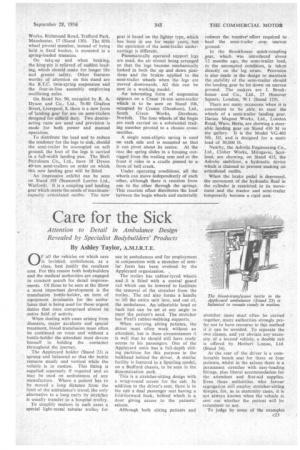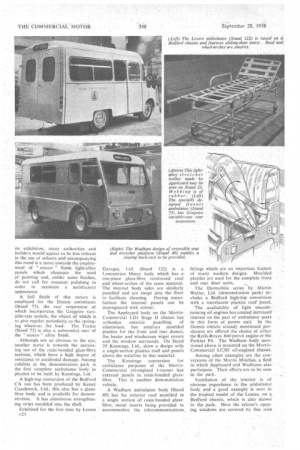Care for the Sick
Page 113

Page 114

Page 115

If you've noticed an error in this article please click here to report it so we can fix it.
Attention to Detail in Ambulance Design Revealed by Specialist Bodybuilders' Products
By Ashley Taylor, A.M.I.R.T.E.
0 F all the vehicles on which care is lavished, ambulances, as a class, best justify the resultant cost. For this reason both bodybuilders and the -medical authorities are engaged in constant search for detail improvements. Of those to be seen at the Show a most important ,development is the transfusion bottle-holder, an item of equipment invaluable for the ambulance that is being used for those urgent duties that once comprised almost its entire field of activity.
When dealing with eases arising from disasters, major accidents and special treatment, blood transfusion must often be continued en route and without a bottle-holder the attendant must devote himself to holding the container throughout the journey, The Appleyard holder (Stand 23) is sprung and balanced so that the bottle remains steady and vertical while the vehicle is in motion. This fitting is supplied separately if required and so may be used on ambulances of any manufacture. Where a patient has to be moved a long distance from the limit of the ambulance's travel, the only alternative to a long carry by stretcher is usually transfer to a hospital trolley.
To simplify matters in such cases a special light-metal tubular trolley for
use in ambulances and for employment in conjunction with a stretcher of similar form has been evolved by the Appleyard organization. ‘.
The trolley has rubber-tyred wheels and it is fitted with a central guard rail which can be lowered to facilitate the removal of the stretcher from the trolley. The rail also forms a handle to lift the entire unit into, and out of, the ambulance. An adjustable head or back rest can be set at any angle to meet the patient's need. The stretcher has Pirelli rubber-webbing supports.
When carrying sitting patients, the driver must often work without an attendant, but in these circumstances it is well that he should still have ready access to his passengers. One of the Appleyard units has a full-depth sliding partition for this purpose in the bulkhead behind the driver. A similar facility is featured in a Spurling model, on a Bedford chassis, to he seen in the demonstration park.
This is a stretcher-sitting design with a wrap-round screen for the cab. In addition to the driver's seat, there is in the cab a dual iiassenger seat having a fold-forward back, behind which is a door giving access to the patients' saloon.
Although both sitting patients and stretcher cases must often be carried together, many authorities strongly prefer not to have recourse to this method if it can be avoided. To separate the two classes, and yet obviate any necessity of a 'second vehicle, a double cab is offered by Herbert Lomas, Ltd (Stand 54).
At the rear of the driver is a comfortable bench seat for three or four patients, whilst in the saloon there is a permanent stretcher with easy-loading fittings, plus liberal accommodation for the attendant and first-aid supplies. Even those authorities who favour segregation still employ stretcher-sitting designs, for, as in maternity cases, it is not always known when the vehicle is sent out whether the patient will be recumbent or not.
To judge by some of the examples c23 on exhibition,, many authorities and builders would appear to be less reticent in the use of colours and'accompanying this trend is a move towards the employment of " stucco" finish light-alloy panels which eliminate the need of painting and, unlike some finishes, do not call for constant polishing in order to maintain a satisfactory appearance.
A full finish of this nature is employed for the Dennis ambnlance (Stand 75), the rear suspension of which incorporates the Gregoire variable-rate systein, the object of which is to give regular periodicity to the springing whatever the load. The Trojan (Stand 72) is also a substantial user of the " stucco " alloy finish.
Although not so obvious to the eye, another move Is towards the increasing use of the resin-bonded glass-fibre sections, which have a high degree of resistance to accidental damage. Among exhibits in the demonstration park is the first complete ambulance body in plastics to he built by Kennings, Ltd.
A high-top conversion of the Bedford CA van has been produced by Kenex Coachwork, Ltd.; this also has a glassfibre body and is available for demonstration. It has aluminium strengthen-. ing strips moulded into the shell.
Exhibited for the first time by Levers c:24 Garages, Ltd, (Stand 122) is a Lancastrian Minor body which has a. one-piece glass-fibre reinforced roof and wheel-arches of the same material. The internal body sides are similarly panelled' and are swept into the floor
to facilitate cleaning. During manufacture the internal panels can be impregnated with colour.
The Appleyard body on the MorrisCommercial LDI Stage II chassis has orthodox exteridr panelling of aluminium, but employs moulded plastics for the front and rear domes, the heater and windscreen wiper covers and the window surrounds. On Stand 29 Kennings, Ltd., show a design with a single-section plastics roof and panels above the waistline in that material, The Kennings conversion for ambulance purposes of the MorrisCommercial oil-ertgined 1-tonner has external panels in resin-bonded glassfibre, This is another demonstration vehicle.
A Wadham ambulance body (Stand 49) has the exterior roof moulded in a single section of resin-bonded glassfibre, metal inserts being provided to accommodate the telecommunications_ fittings which are an important feature of many modern designs. Moulded plastics are used for the complete front and rear door units,
The Dormobile series by Martin Walter, Ltd. (demonstration park) includes a Bedford high-top conversion with a translucent, plastics roof panel.
The availability of light smoothrunning oil engines has created increased• interest on the part of ambulance users in this form of power unit. In the Dennis vehicle already mentioned purchasers are offered the choice of either the Rolls-Royce B40 petrol engine or the Perkins P4. The Wadham body mentioned above is mounted on the Morris-. Commercial LC/05 oil-enginecl chassis.
Among .other, examples are the conversions Of the Morris Minibus, a field . in which Appleyard and Wadhams also participate. Their efforts are to be seen in the park.
Ventilation of the interior is of obvious importance in the ambulance body and a good example is seen in the tropical model of the Lomas, on a Bedford chassis, which is also shown in the park. Here the saloon's opening windows are covered by fine wire mesh. Natural force intakes are formed in the front dome above the screen.
In ventilation generally one practice, as in the Lomas-Karrier, is for the intakes to carry the fresh air to the cab and for its entry to the patients' compartment to be regulated by a hitand-miss disc device or other similar means.
On the Wadham design the air from the intakes over the screen is fed to a 4kW. body-heater. In view of the need for ambulances going into action with the least possible delay when an emergency call is received, purchasers are usually generous in their approach to supplementary equipment such as quick-action demisters which will be noted in several cases.
Provision for telecommunications equipment on one of the Wadham machines has already been noted and one example from this builder has the set in situ. A number of other manufacturers provides similar two-way radio equipment.
Ease of entry is almost a commonplace in today's designs, but the disabilities of individual patients will con-: tinue to give rise to problems for the drivers and attendants who-are responsible for the comfort of their charges. Although not unique. the Karrier
ambulance (Stand 77), with the Lomas body, • forms 4 good example of the wide folding step, giving a three-riser entry into the interior. The bottom step turns over in such a manner as to fill the gap in the floor when the rear doors are closed.
In relatively recent times, when both the suspension of commercial vehicles was less refined and the call on the ambulance services for treatment cases was less heavy, there was a strong trend towards semi-luxury designs in this cotintry. This was a situation that sometimes caused surprise to overseas visitors, who regarded British road surfaces with approval. Without stinting the necessities, the move is now fdr judicious avoidance of undue financial expenditure.
Australia, represented on the Lomas stand, has one of the more elegant models, this employing an Austin A135 chassis. The interior has a permanent stretcher with easy-loading equipment on one side and a combined platform-seat on the other. The body is of composite construction, . As they have their own summer showing at the Conference of the Institute of Public Cleansing, vehicles devoted to refuse collection and associated duties do not appear in any quantity on this occasion. However, a feature of some interest is being demonstrated by the Eagle Engineering Co., Ltd. (Stand 126). This takes the form of resin-bonded plastics sliding covers of the Chelseatype of collection vehicle. Using this material it is possible for the covers to withstand rough treatment. As the handles are moulded-in, a prevalent source of trouble is eliminated. The covers are shown in painted and in colour-impregnated forms.
Obvious benefits to be obtained from such plastics covers are resistance to corrosion and the ability to withstand rough treatment. Lightness may also be appreciated.
In the particular design, both die near-side and the corresponding off-side covers work in the same slide. Thus, if the near side is open, and the off side is moved from the closed to the open position, the near side automatically closes. Stability is given to the lower edge of the cover by a steel bar, which is moulded in.
A 7-cu.-yd. Chelsea-type refuse collection body on a 2-ton Karrier Bantam chassis, which will be sent to Colombo, is being exhibited by British Light Steel Pressings, Ltd. (Stand 115). The cab, a product of the exhibitors, has a bucket seat for the driver and a passenger scat for two loaders.
Other claimants on the public purse are, of course, the fire engines. These include the Maudslay Merlin Mark II lightweight fire engine and a LandRover tender. A new type is the Dennis F24 with the Rolls-Royce fully automatic transmission and synchromesh multi-way transfer box.




































































































































































